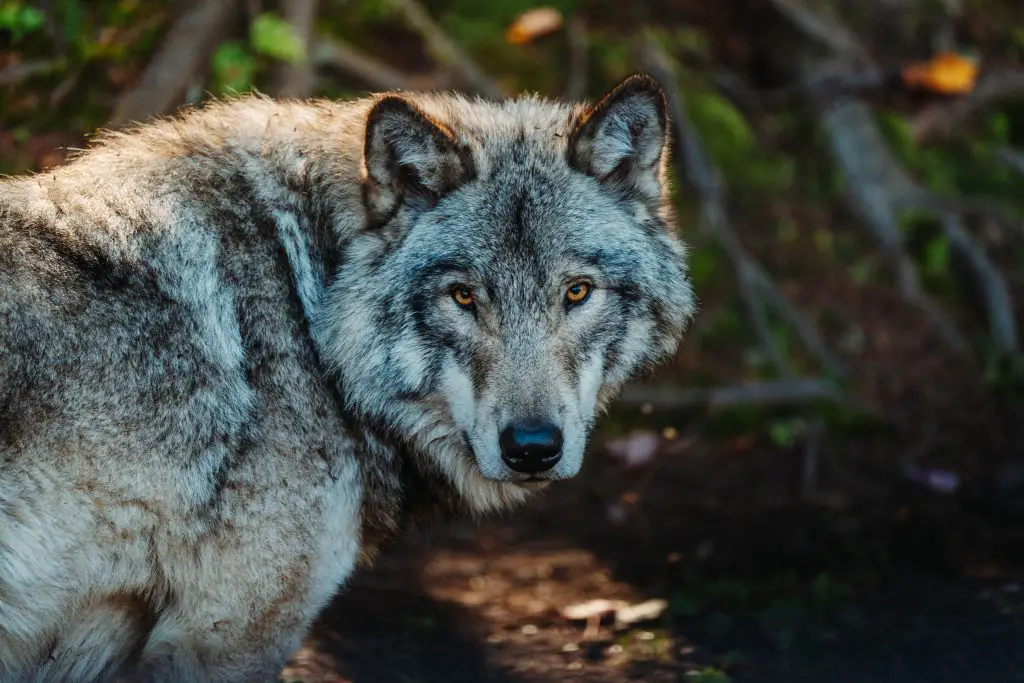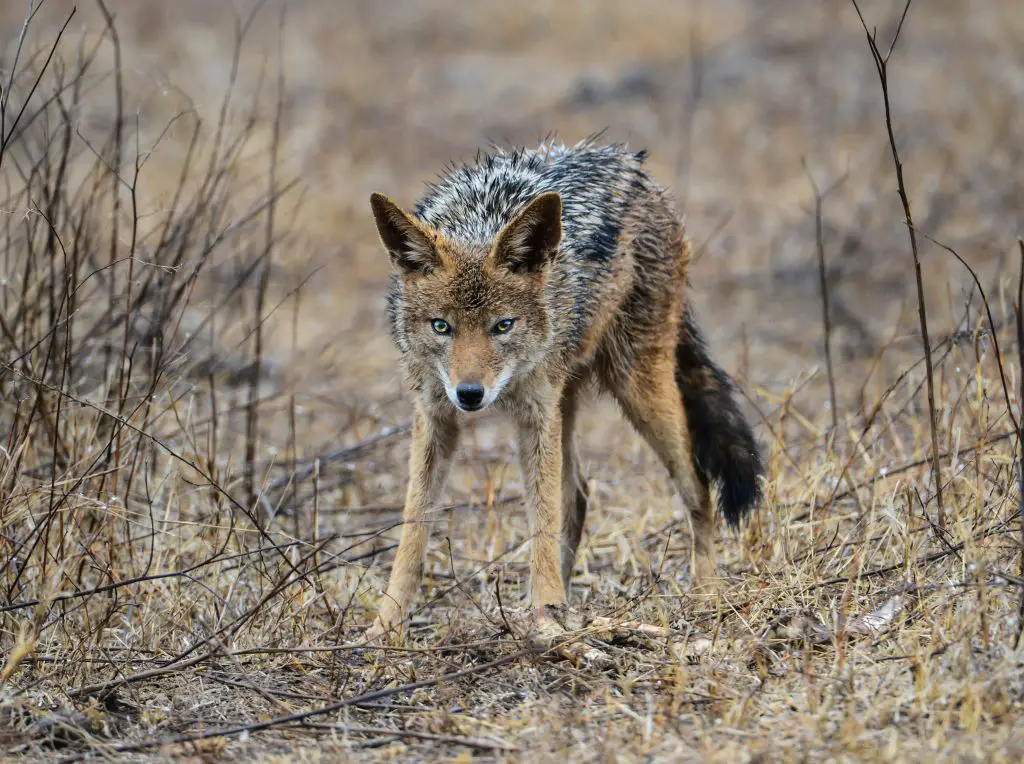If you’re out in the wild and come across a wild canine, you’ll want to know how to tell a wolf from a coyote. You want to be sure you’re not mistaking these wild animals for domestic dogs, especially in urban environments. In this article, we’ll run through several ways to identify the separate species, outlining the main differences as well as similarities.

How to Tell a Wolf from a Coyote by Their Appearance
When trying to tell a wolf from a coyote by appearance, look for these key differences:
- The biggest difference is the size difference. Wolves are typically much larger animals than coyotes, with males weighing up to 175 pounds compared to coyotes’ 35-45 pound range. Wolves also have longer legs, wider chests, and narrower waists. Adult coyotes have narrow chests, slender faces, narrow snouts and the legs of a coyote are much shorter. They are similar in size to a medium size dog whereas wolves are much larger, and would be as big as a very large dog, if not larger.
- Wolves also have larger ears that stand up straight on their heads, whereas coyotes’ ears tend to be smaller and more pointed.
- Wolves usually have darker fur than coyote, with blacks and dark brown coloration, vs. lighter browns and grays for coyotes.
- Coyotes have bushier tails, which they hold low to the ground when running. Adult wolf tails are slimmer, and wolves hold their tails upright away from their body when running.
While both animals are similar in some ways, there are definitely some key physical differences that you can use to tell them apart.

How to Tell a Wolf from a Coyote by Their Behavior
Most people can tell a wolf from a coyote by their size, but did you know that you can also tell them apart by their behavior?
Wolves are generally more social animals than coyotes, and this is reflected in their behavior. For example, while both wolves and coyotes will hunt in packs, coyotes are more likely to hunt alone or in pairs.
Additionally, coyotes are more likely to be seen during the day, while wolves are more active at night. Of course, there are exceptions to every rule, but in general, these behavioral differences can help you tell a wolf from a coyote.
How to Tell a Wolf from a Coyote by Their Habitat
Wolves are typically found in areas of dense forest, while coyotes tend to stick to more open areas like fields or deserts. As people have spread and there are more urban areas and suburban areas encroaching on their habitat, Coyotes have also adapted to live in these areas and co-exist with humans, whereas wolves will not and will leave the area if human beings encroach on wolf habitat.
Additionally, wolves will often form wolf packs and live together in family groups, while coyotes are generally solitary creatures. However, there are some instances where it can be difficult to tell these two animals apart.
How to Tell a Wolf from a Coyote from Their Tracks
If you’re out on a hike and you see some animal tracks, how can you tell if they’re from a wolf or a coyote?
It’s actually not too difficult – here are some things to look for:
- First, take a look at the size of the tracks. Wolves have large feet and therefore their tracks are typically much larger than those of coyotes – about twice as big, in fact. So, if the tracks you’re seeing are on the large side, they’re probably from a wolf.
- Next, take a look at the shape of the tracks. Wolf tracks tend to be more oval-shaped than coyote tracks, which are more triangular. Wolves also are more likely to slightly drag their back feet, particularly in deeper snow.
- Finally, take a look at the claws. Wolf claws are usually longer and more visible than those of coyotes.
Keep these things in mind and you should be able to tell a wolf from a coyote by their tracks!
Howling vs Coyote Yips
Coyote and wolf vocalizations are actually pretty distinct.
Wolf howls are much deeper and harsher than a coyote’s, and they are more drawn out. Think of the typical wolf howl you’ve heard in movies or on TV, and that’s actually pretty accurate!
Coyotes have more of a high-pitched yip which they often repeat several times in a row while communicating with each other. Although coyote howls are less common, if you hear high-pitched howls that is likely coyotes, although it could be wolf pups practicing as well!
What Are Wolves?
Wolves are the largest non-domestic members of the dog family and are the ancestors of all domesticated dogs. Canis Lupus is their taxonomic name. These large, carnivorous predators eat prey ranging from large animals like deer, elk, and bison to smaller animals like rabbits, birds, and mice.
Although rare, wolves have also been known to attack pets. Wolf attacks are incredibly rare on humans, and typically if they occur the authorities will hunt down and remove the problem animals.
An adult male wolf typically weighs between 75 and 120 pounds, while females are a bit smaller, weighing between 60 and 95 pounds.
In North America – all wolves are Gray wolves (Canis Lupus), vs. Red Wolves (Canis Rufus) which are found in other parts of the world.
There are currently thought to be four main subspecies of gray wolf in North America – The Arctic Wolf which resides in northern Canada and the arctic, the Great Plains Wolf which ranges over Minnesota, Wisconsin and Michigan, the Northwestern Gray Wolf, or Rocky Mountain wolf, which inhabits parts of the western United States, western Canada, and Alaska. This is the subspecies reintroduced into Yellowstone in the mid 1990’s. The final is the Mexican Gray Wolf, which is found primarily in the southwestern US, Mexico and into central america as the name implies. The Eastern Timber Wolf is currently being debated as a fifth subspecies by the scientific community.
In the wild, wolves have a lifespan somewhere between 10 and 16 years.
For many years, Wolves were actively hunted in the United States as they were viewed as a nuisance animal. By the mid 1900’s, wolves were an endangered species. They still are in many areas, although with federal and state protection in recent years, the wolf population has greatly rebounded from the all-time lows.
What Are Coyotes?
Coyotes, or Canis latrans, are medium-sized members of the non-domesticated dog family. Adult male coyotes weigh between 34 and 47 pounds, while adult female coyotes weigh between 33 and 40 pounds.
These carnivorous predators prey primarily on small mammals such as mice, rabbits, and squirrels. While they prefer fresh meat, they will also eat the rotting flesh of already dead animals. They’re usually not large enough to go after larger prey such as adult deer, but they will prey on fawns.
Although Coyotes are actively hunted as well, the coyote population is much higher, and coyotes tend to reproduce much more quickly than wolves with a much shorter gestation period and larger litters. Some studies have even shown that coyotes have larger litters if they are in an area with a lower population, and litters shrink if there are many coyotes around!
FAQs in Relation to How to Tell a Wolf From a Coyote
How can you tell if its a wolf?
There are a few ways to tell if it is a wolf or coyote. One way is to look at the size of the animal.
Wolves are typically larger than coyotes. Another way to tell them apart is by looking at their tails.
Wolves have longer tails than coyotes and they also tend to hold their tails down while running, whereas coyotes usually hold their tails up. Finally, you can listen to the sound of their howls.
Wolves have a deeper howl than coyotes.
Do coyotes look like wolves?
Coyotes and wolves share a lot of similarities in their appearance. Both have long snouts, pointed ears, and bushy tails.
However, there are some key differences. Wolves are typically much larger than coyotes, with males weighing up to 175 pounds compared to the 35-pound average for coyotes.
Additionally, wolves have broader chests and longer legs than coyotes. Their fur is also usually darker and thicker than that of a coyote.
Do coyotes howl like wolves?
There is no definitive answer to this question as coyotes and wolves are both capable of making a variety of sounds. However, some people may say that coyotes tend to howl more like dogs, while wolves howl more like birds.
Conclusion
Now that you know the differences between wolves and coyotes, you should have no trouble telling them apart. Remember to look for clues in their appearance, behavior, habitat, and tracks.
With this knowledge, you can enjoy watching these amazing animals without having to worry about getting them confused!

Leave a Reply